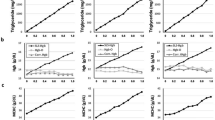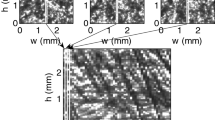Abstract
SOME years ago Macallum, Bradley and Adams1,2 discovered that the absorption spectrum of red corpuscles is entirely devoid of the y or Soret-band —the broad absorption band of hæmoglobin located between 400 and 430 ma—whereas the a-and (3-bands in the visible part of the spectrum remain unaltered. This band appears only after hæmolysis, when intraglobular hæmoglobin becomes free and passes into solution. This phenomenon has since been confirmed by Keilin and Hartree3.
This is a preview of subscription content, access via your institution
Access options
Subscribe to this journal
Receive 51 print issues and online access
$199.00 per year
only $3.90 per issue
Buy this article
- Purchase on Springer Link
- Instant access to full article PDF
Prices may be subject to local taxes which are calculated during checkout
Similar content being viewed by others
References
Macallum, A. B., and Bradley, R., Science, 71, 341 (1930).
Adams, G., Bradley, R., and Macallum, A. B., Biochem. J., 28, 482 (1934).
Keilin, D., and Hartree, E. F., Nature, 148, 75 (1941).
Adams, G., Biochem. J., 32, 646 (1938).
Iljina, A. A., Ravikovich, H. M., Rubinstein, D. L., and Shpolsky E. V., C. R. Acad. Sci., U.S.S.R., 48, No. 5, 325 (1945).
Author information
Authors and Affiliations
Rights and permissions
About this article
Cite this article
RUBINSTEIN, D., RAVIKOVICH, H. Absorption Spectrum of HÆMoglobin in Red Cells. Nature 158, 952–953 (1946). https://doi.org/10.1038/158952a0
Issue Date:
DOI: https://doi.org/10.1038/158952a0
This article is cited by
-
Effects of urban fine particulate matter and ozone on HDL functionality
Particle and Fibre Toxicology (2015)
-
Measurement Science in the Circulatory System
Cellular and Molecular Bioengineering (2014)
-
Strukturprobleme am roten Blutk�rperchen
Die Naturwissenschaften (1950)
Comments
By submitting a comment you agree to abide by our Terms and Community Guidelines. If you find something abusive or that does not comply with our terms or guidelines please flag it as inappropriate.



